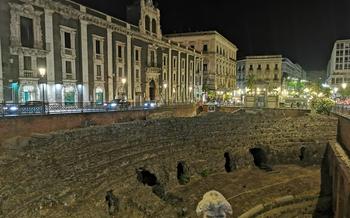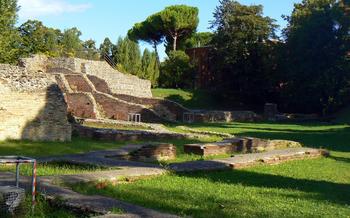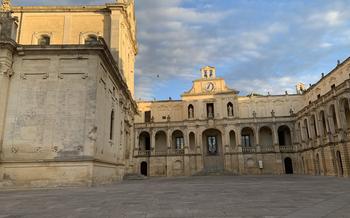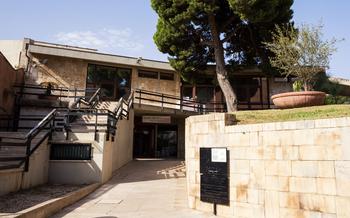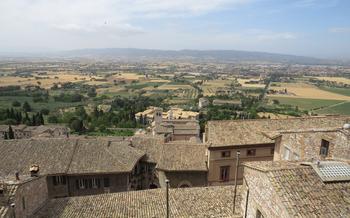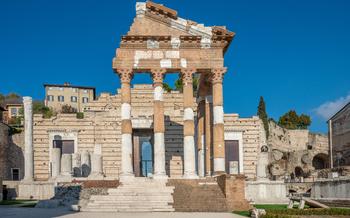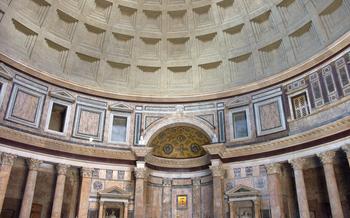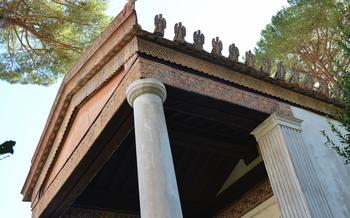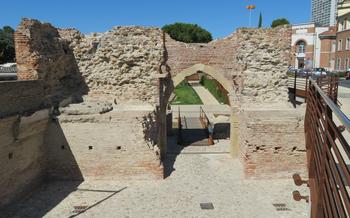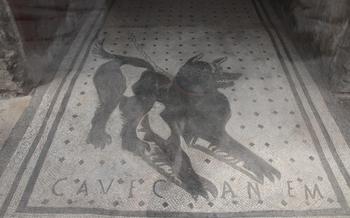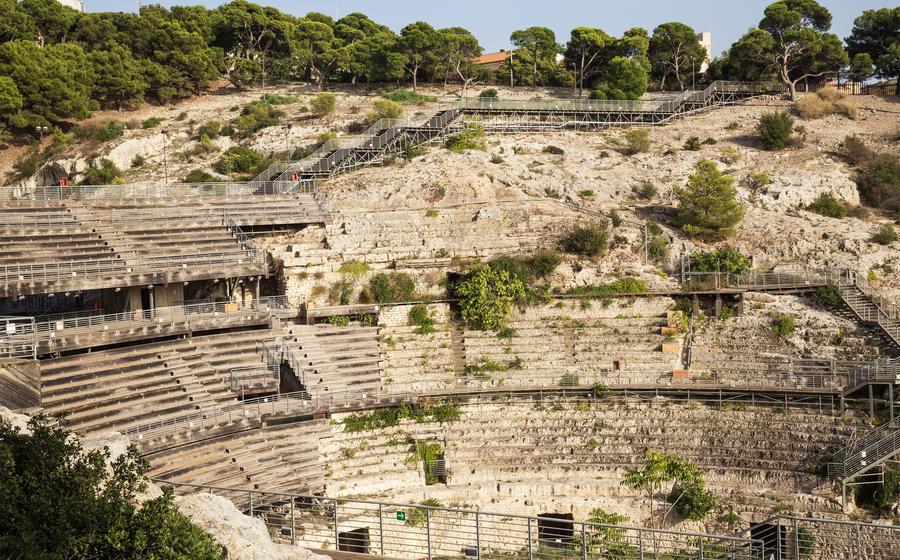
Roman Amphitheater of Cagliari
- Introduction
- Architecture
- Dimensions
- Gladiators
- Wild Animals
- Audience and Social Significance
- Decline and Abandonment
- Rediscovery and Excavation
- Restoration and Preservation
- Visiting the Roman Amphitheater
- Events and Activities
- Insider Tip
Introduction
Nestled in the heart of Cagliari, the Roman Amphitheater stands as a testament to the city's rich history and enduring legacy. Constructed in the 2nd century AD, during the reign of Emperor Marcus Aurelius, this magnificent monument is a symbol of Roman rule in Sardinia. As one of the oldest amphitheaters in Italy, it has witnessed countless spectacles and events that have shaped the cultural and social fabric of the region. Its imposing structure, intricate architecture, and historical significance make it a must-visit destination for anyone seeking to delve into the depths of ancient Roman civilization.
Architecture
The Roman Amphitheater of Cagliari, an exceptional example of Roman architecture, stands out for its unique features. Constructed with precision and artistry, the amphitheater reflects the architectural prowess of the Roman Empire. Its elliptical shape, a defining characteristic, allows for optimal acoustics and clear sightlines from every seat.
The amphitheater's imposing facade, adorned with arches and pilasters, showcases the grandeur of Roman design. The use of local limestone, quarried from nearby hills, adds a touch of regional authenticity to this architectural masterpiece. The seating tiers, skillfully arranged, provide spectators with exceptional views of the arena.
In comparing the Roman Amphitheater of Cagliari to other prominent Roman amphitheaters, such as the Colosseum in Rome or the Arena in Verona, it exhibits remarkable similarities as well as distinct differences. While sharing common features, such as the elliptical shape and seating arrangement, the Cagliari amphitheater distinguishes itself through its smaller scale, hinting at the size of the ancient city it served.
A closer examination reveals the intricate construction techniques employed by the Romans. The amphitheater was built using a combination of opus quadratum and opus incertum, showcasing the empire's mastery of both regular and irregular stonework. The vaults and arches, meticulously constructed, demonstrate the Romans' understanding of structural engineering and their ability to create durable and awe-inspiring structures.
Dimensions
The Roman Amphitheater of Cagliari, with a capacity of approximately 10,000 spectators, is considered a medium-sized amphitheater compared to other Roman amphitheaters. The seating arrangements consisted of tiered rows of seats divided into several sections. The lower rows, closest to the arena, were reserved for officials and dignitaries, while the upper rows were for the general public. The arena itself measured approximately 65 meters in length and 45 meters in width, providing ample space for gladiatorial contests and other spectacles. Additionally, there was a stage at one end of the arena, used for theatrical performances and other events.
Gladiators
The history of the Roman Amphitheater of Cagliari is intrinsically linked to the gladiatorial contests that took place within its walls. Gladiators were individuals who fought against each other, often to the death, for the entertainment of the Roman population. They came from various backgrounds, including slaves, criminals, and even volunteers.
Gladiators underwent rigorous training to prepare for combat. They learned how to use different weapons, such as swords, spears, and nets, and developed fighting techniques to ensure their survival in the arena. Different types of gladiators existed, each specializing in specific combat styles. Some of the most famous types included the retiarius, who fought with a net and a trident, and the murmillo, who was equipped with a sword and a shield.
Gladiatorial contests held immense significance in Roman society. They were seen as a form of entertainment, a display of courage and strength, and a way to honor the gods. The outcome of these contests was often determined by the audience, who could express their favor or displeasure through cheers or jeers. Victors were celebrated as heroes, while those who were defeated faced a grim fate.
Wild Animals
The Roman Amphitheater of Cagliari was not only a stage for gladiatorial contests but also a venue for public spectacles involving wild animals. These animals were often used in hunts, fights, and other events designed to entertain and thrill the audience. Lions, tigers, bears, and other exotic species were brought from distant lands to participate in these spectacles. The animals were trained by specialized handlers known as bestiarii, who ensured their obedience and ferocity during the performances.
The use of wild animals in the amphitheater was a reflection of the Roman fascination with the natural world and their desire to demonstrate their power and control over it. The animals were seen as symbols of strength, courage, and danger, and their presence in the arena added an element of unpredictability and excitement to the events. The roars of the lions, the growls of the tigers, and the snarls of the bears echoed through the amphitheater, creating an atmosphere of tension and anticipation.
Audience and Social Significance
The Roman Amphitheater of Cagliari welcomed a diverse audience from all walks of life. The lower classes, including slaves, laborers, and artisans, made up a large portion of the spectators. They sought entertainment and escape from their daily struggles. The middle class, consisting of merchants, shopkeepers, and civil servants, also frequented the amphitheater, driven by a combination of entertainment and social status. The elite, including wealthy landowners, senators, and government officials, had reserved seating and often displayed their extravagance through lavish clothing and jewelry.
The motivations for attending events at the amphitheater were complex and varied. Some spectators were drawn to the thrill and excitement of gladiatorial contests, the bloodshed and violence serving as a form of catharsis. Others were fascinated by the exotic animals and the skill of the animal trainers. Still, others attended for social reasons, using the amphitheater as a venue to socialize, network, and display their wealth and status.
Gladiatorial contests held a significant social and political meaning in Roman society. They were not merely spectacles but also served as a form of social control, providing a symbolic outlet for expressing aggression and resolving social tensions. The contests reinforced the values of strength, courage, and loyalty, qualities that were highly prized in Roman culture. Additionally, the games demonstrated the power and authority of the Roman state, reaffirming its dominance over its subjects.
The amphitheater, with its capacity to accommodate thousands of spectators, acted as a powerful symbol of Roman authority and unity. It was a place where people from different backgrounds and social classes came together to experience shared emotions, fueling a sense of community and belonging. The amphitheater thus played a crucial role in shaping the social and political fabric of Roman society.
Decline and Abandonment
As the Roman Empire declined, so too did the popularity of gladiatorial contests and public spectacles. The rise of Christianity and the growing influence of the Christian church played a significant role in this decline, as the church condemned the violence and brutality of these events. Additionally, the financial burden of maintaining and organizing these spectacles became increasingly difficult for many Roman cities to bear. As a result, the Roman Amphitheater of Cagliari, like many others across the empire, was gradually abandoned and fell into disrepair. The lack of maintenance and neglect, coupled with the effects of time and natural disasters, led to the amphitheater's deterioration and eventual ruin. Over time, the once-vibrant arena became overgrown with vegetation and obscured by debris, fading into obscurity and becoming a forgotten relic of the past.
Rediscovery and Excavation
The Roman Amphitheater of Cagliari lay buried beneath layers of soil and vegetation for centuries, forgotten and lost to time. Its rediscovery in the late 18th century was a chance occurrence when a local farmer, while plowing his field, stumbled upon ancient stone ruins. Intrigued, he alerted the authorities, and soon excavations began under the supervision of archaeologists and historians.
The initial excavations were met with challenges, as the amphitheater was covered in dense vegetation and the soil had hardened over time. The archaeologists meticulously removed layers of earth, revealing the amphitheater's structure bit by bit. As the excavations progressed, they unearthed numerous artifacts and architectural elements, providing valuable insights into the amphitheater's history and design.
The rediscovery of the Roman Amphitheater of Cagliari was a significant event, not only for the city but also for the world of archaeology. It shed new light on the Roman presence in Sardinia and provided a glimpse into the grandeur of ancient Roman architecture. The amphitheater became a symbol of Cagliari's rich history and a testament to the enduring legacy of the Roman Empire.
Restoration and Preservation
Maintaining the legacy of the Roman Amphitheater of Cagliari required extensive restoration and preservation efforts after its rediscovery. Striking a balance between conserving the historical integrity of the site and adapting it for modern use posed a significant challenge.
Archaeologists and restoration experts meticulously restored damaged sections, utilizing techniques that mirrored the original construction methods. This involved the use of traditional materials like limestone and brick, ensuring the preservation of the amphitheater's authenticity.
The primary goal was to stabilize the structure while minimizing the impact on its historical features. For instance, modern materials were strategically employed in areas where structural reinforcement was crucial without compromising the overall aesthetic.
Today, visitors can wander through the restored portions of the amphitheater, appreciating its grandeur while understanding its resilience over time. These efforts have transformed the Roman Amphitheater of Cagliari into a living testament to the enduring legacy of ancient Rome.
Visiting the Roman Amphitheater
To fully immerse yourself in the history and grandeur of the Roman Amphitheater of Cagliari, visiting in person is a must. The amphitheater is typically open to the public during specific hours, with admission fees varying depending on the time of year and any special events. Guided tours are available for visitors who want a more in-depth experience, with knowledgeable guides providing insights into the amphitheater's history, architecture, and significance. Additionally, audio guides are offered in multiple languages for those who prefer a self-guided exploration.
Exploring the amphitheater at your own pace allows you to appreciate its unique features and imagine the spectacle of events that once took place within its walls. As you wander through the ancient passageways and seating areas, let your mind wander back to the days when gladiators battled for their lives, wild animals roamed the arena, and crowds cheered for their favorite fighters. Take time to admire the intricate carvings and decorative elements that adorn the amphitheater, remnants of the artistry and craftsmanship of the Roman era.
Whether you choose a guided tour or explore independently, don't miss the opportunity to visit the museum located within the amphitheater. Here, you can learn more about the history of the amphitheater, view artifacts unearthed during excavations, and gain a deeper understanding of the significance of this remarkable landmark.
To make the most of your visit, consider exploring the surrounding area, which offers a variety of restaurants, cafes, and shops. This will allow you to immerse yourself further in the culture and history of Cagliari and Sardinia.
Events and Activities
The Roman Amphitheater of Cagliari is not only a historical landmark but also a vibrant venue for cultural events, concerts, and performances. The amphitheater's unique atmosphere and acoustics make it an ideal setting for a variety of artistic expressions.
Throughout the year, the amphitheater hosts a range of cultural events, including theater productions, dance performances, and musical concerts. These events showcase local and international talent, providing visitors with an opportunity to experience the amphitheater's rich cultural heritage and contemporary creativity.
Educational programs and workshops are also offered at the Roman Amphitheater, catering to visitors of all ages. These programs provide insights into the history, architecture, and significance of the amphitheater, as well as hands-on activities related to Roman culture and gladiatorial contests.
In addition, the amphitheater is occasionally used as a venue for contemporary events and productions, such as fashion shows, product launches, and historical reenactments. These events offer a unique blend of history and modernity, allowing visitors to experience the amphitheater in a new and exciting way.
Insider Tip
To fully immerse yourself in the historical atmosphere of the Roman Amphitheater of Cagliari without battling crowds, consider visiting during the shoulder season (April-May and September-October) when the weather is still pleasant but there are fewer tourists. For a truly unique experience, explore the underground chambers and passageways beneath the amphitheater, which are only accessible through guided tours. There, you can discover hidden rooms and tunnels that once served as animal pens, gladiators' quarters, and storage areas. To further enrich your visit, engage the services of a knowledgeable local guide who can provide captivating insights into the amphitheater's rich history and significance, bringing the past to life with their storytelling.
